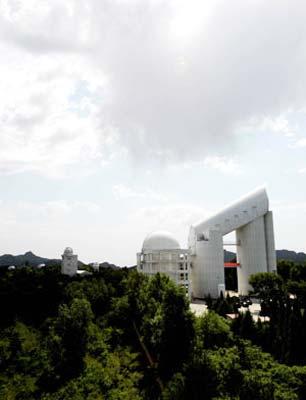China's finest telescope to scan most celestial spectra
2009-06-08 09:40 BJT
BEIJING, June 4 (Xinhua) -- China built the finest optical telescope to scan 10 million celestial spectra in the coming five-to-six years, one of the world's most ambitious astronomical endeavors to record key data betraying how the universe was formed.
The Chinese government, which awarded the 235 million-yuan (34 million U.S. dollars) contract to a consortium of elite astronomers and engineers, officially unveiled Thursday the Large Sky Area Multi-Object Fiber Spectroscopic Telescope (LAMOST), the biggest telescope of its kind in the world.
 |
| The undated file photo shows the exterior of the Large Sky Area Multi-Object Fiber Spectroscopy Telescope (LAMOST) in Xinglong, Hebei Province, north China. The LAMOST of the Xinlong Station of National Astronomical Observatories under Chinese Academy of Sciences passed the national examination on June 4. The telescope with a reflecting Schmidt corrector MA and a spherical primary mirror MB is the largest of its kinds in the world. The size of MB is 6.67m x 6.05m, while that of MA is 5.72m x 4.40m, and the effective aperture in diameter is 3.6m-4.9m. The LAMOST will be able to observe 4,000 astronomical spectrum during a period of 1.5 hours in a single night. (Xinhua photo) |
The research team, led by Cui Xiangqun, a world-renowned active optics expert who heads the Nanjing Institute of Astronomical Optics and Technology under the Chinese Academy of Sciences (CAS), made a breakthrough in synchronized movements of 24 hexagonal mirrors of a Schmidt reflecting corrector, which is used to track celestial bodies for scientific analyses.
Cui and her team even made each mirror piece, 1.1 meters in diametrical length, capable of deformation for more precise targeting and error correction in observations. Light from celestial bodies are reflected to a bigger spherical mirror, made up of 37 same-sized hexagonal mirrors in a similar way.
With the 3.6-meter-aperture reflector and the 4.9-meter-aperture spherical mirror, together with a focal plane mounted with 4,000 optical fibers, all cutting-edge technologies, scientists, could ascertain spectra of 2.5 million fixed stars, 2.5 million galaxies, 1.5 million brighter cluster galaxies and one million quasi-stellar objects, mostly in the north celestial sphere.
All the 10 million spectra are expected to be completed within five-to-six years, Cui said, adding that the data would be subsequently accessible to global scientists.
Spectra are key for astronomers to read celestial bodies' chemical composition, density, atmosphere and magnetism. So far, the science community have found the existence of billions of celestial bodies, but have only managed to collect spectra of about one in every 10,000 of them.
The ambitious goal of collecting so much data encouraged Cui and her team to overcome the obstacles making a super large telescope that has both a big aperture and wide field of view.
Inspired by her mentor Su Dingqiang, a leading Chinese astronomer who is also a prestigious CAS member, the 58-year-old Cui combined a 15-story-high scope, missile silo-like observatory tower on top of a 960-meter hill 170 kilometers northeast of Beijing.
During observation nights, the upper parts of the lower dome are removed and starlight is reflected from the mirror up through the 40-meter tube to the primary mirror.
The light of space is fed into the front ends of optical fibers positioned on a focal plane, before real-time data are recorded into spectrographs fixed in a room underneath.
The idea was developed from the spherical and aspherical mirror combination, invented by German opticist B. V. Schmidt in 1931. It also uses advanced active optics technologies.

 Mail
Mail Share
Share Print
Print


 Video
Video









 2009 China Central Television. All Rights Reserved
2009 China Central Television. All Rights Reserved